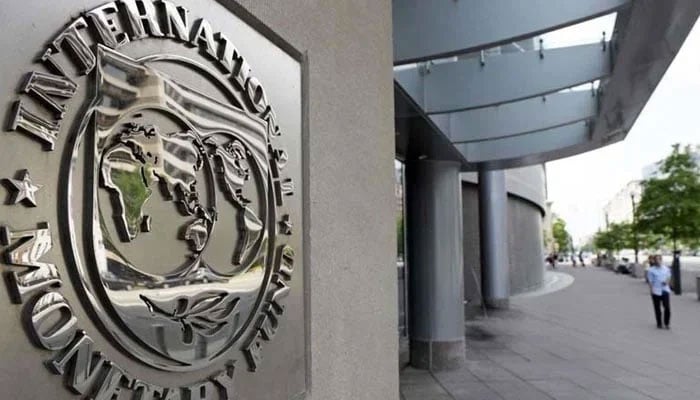About new IMF programme, the Fund staff stated that downside risks remain exceptionally high  The International Monetary Fund's (IMF) building in Washington, United States. — AFP/File
The International Monetary Fund's (IMF) building in Washington, United States. — AFP/File
ISLAMABAD: The International Monetary Fund (IMF) has warned Pakistan that policy slippages together with lower external financing could undermine the narrow path to debt sustainability and place pressure on the exchange rate in post-Standby Arrangement (SBA) scenario.
The IMF also wants the rebasing of power tariff with effect of from July 1, 2024 to align the cost recovery of power tariff and additional measures in case of shortfall in FBR revenues in May 2024.
About new IMF programme, the Fund staff stated that downside risks remain exceptionally high.
While the new government has indicated its intention to continue the SBA’s policies, political uncertainty remains significant. A resurgence in social tensions (reflecting the complex political scene and high cost of living) could weigh on policy and reform implementation. The IMF’s five- ember team arrived in Islamabad and it’s expected that the mission chief Nathan Porter would also join them on this weekend. Three more IMF officials are expected to land Islamabad on this weekend and talks would start from next week. Ministry of Finance high-ups exchanged data on Friday with the IMF team. “Timely notification of the FY25 annual rebasing will be critical to the continued prevention of further Circular Debt (CD) flow, as will further collections efforts, including steps to enhance and institutionalise digital monitoring. In parallel, the authorities should press ahead with agricultural tube-well subsidy reform, for which a finalised plan is targeted by end-FY24,” the IMF made it clear. The IMF report released on Friday after completion of second review and third tranche for Pakistan said that signs of Pakistan’s economic stability are strong and this year Pakistan’s economic growth is likely to be 2 percent while the growth rate will increase to 3.5 percent in the next financial year. The average inflation this year will be 24.8 percent, and next year it will come to 12.7 percent while unemployment at 8 percent this year and likely to fall to 7.5 percent. Fiscal deficit is 7.5 percent this year and likely to be 7.4 percent of GDP next year.
This year, the current account deficit will be limited to minus 0.8 percent of GDP while the current account deficit will be negative 1.2 percent next year. The Washington-based lender mentioned that all agreed contingency measures will be adopted should collections fall short on FBR’s front. Additional efforts are also needed to meet the SBA’s revenue administration goals. Efforts to collect additional revenue from retailers have been delayed, and challenges continue in the tobacco sector where, despite the mandatory implementation of track-and-trace systems, smuggling and clandestine production continue despite efforts to curtail informal production and imports. The FBR is expanding its track-and-trace system to additional commodities such as sugar, fertilizer, and cement to tighten control over informal markets in these sectors. The FBR has, however, successfully registered 1.1 million new filers, from which 170,999 new returns have been obtained through enforcement measures, with the remainder coming voluntarily.
“Delays in post-programme external financing disbursements would also place further pressure on banks to finance the government (further exacerbating crowding out of the private sector). Geopolitically driven higher commodity prices and disruptions to shipping, or tighter global financial conditions, would also adversely affect external stability,” the IMF stated. Consistent implementation of stronger policies over the past nine months has brought the economy back from the brink and onto a path of stability. A gradual economic recovery has increasingly taken hold and inflation has declined substantially in recent months, though remaining well above target. The SBP has taken advantage of increased inflows, easing external pressures, and the moderation of the current account deficit to begin rebuilding FX reserves. Fiscal performance has also improved, with the government posting a large primary surplus in first half of the current fiscal year. This overall satisfactory performance suggests that unwavering and consistent policy implementation can bring positive results, rebuild confidence, and support economic recovery.
Although this SBA broadly achieved its narrow objectives, the challenges ahead remain uncomfortably high and will require sustained efforts to effectively address them. Pakistan’s fiscal and external vulnerabilities remain very high, including debt sustainability and refinancing risks as well as crowding out of the private sector, and structural weaknesses constrain productivity, investments, and growth. The SBA recognised that resolving Pakistan’s structural challenges will require continued adjustment and creditor support beyond the programme period. It is now critically important that the effort that started under this SBA continues, the report said.
In this regard, the Pak authorities’ interest in a successor arrangement is welcomed to anchor the policy adjustment in the coming years, restore Pakistan’s medium-term sustainability, and pave the way for strong and inclusive growth.












